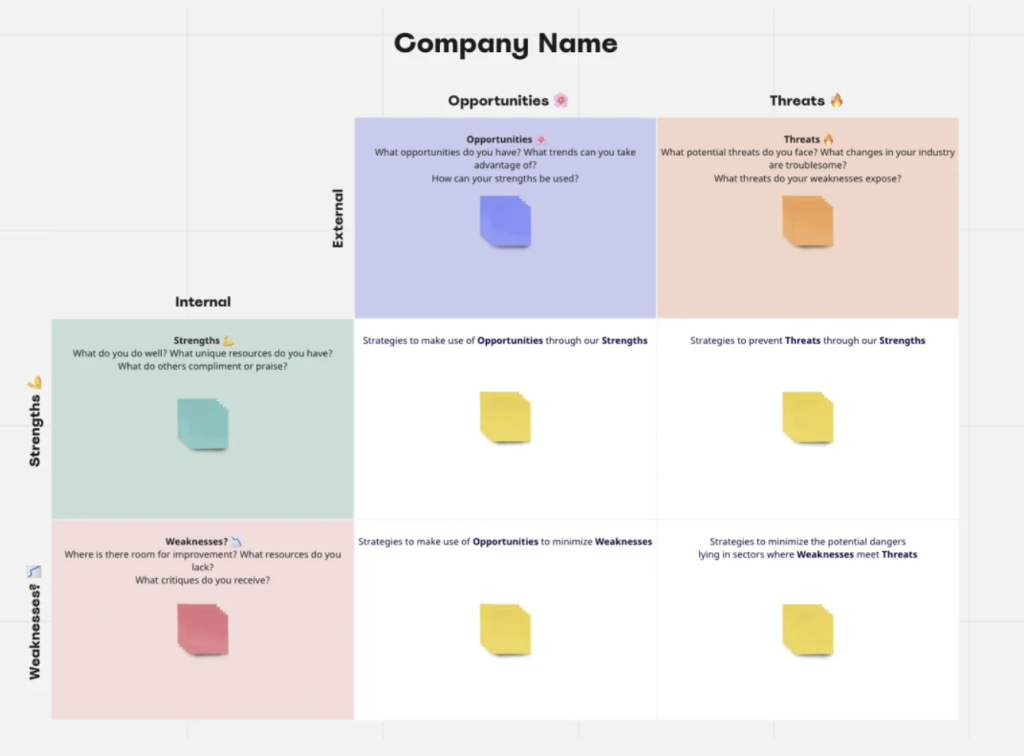A SWOT analysis is a strategic planning tool used by businesses and organizations to identify their strengths, weaknesses, opportunities, and threats. It provides a comprehensive overview of the internal and external factors that can impact the success of a project, product, or business. In this article, we will explore when it is appropriate to perform a SWOT analysis and how it is done effectively. We will delve into the various scenarios where a SWOT analysis can be beneficial and provide a step-by-step guide on how to conduct one.
When to Perform a SWOT Analysis
Performing a SWOT analysis can be beneficial in various situations. Here are some common scenarios where a SWOT analysis can be useful:
1. Strategic Planning
One of the primary uses of a SWOT analysis is during the strategic planning process. Before setting goals and objectives, it is essential to understand the internal and external factors that can influence the success of the plan. By conducting a SWOT analysis, organizations can identify their strengths and weaknesses, as well as the opportunities and threats in the market. This information can then be used to develop strategies that leverage strengths, address weaknesses, capitalize on opportunities, and mitigate threats.
Strategic planning involves setting the direction for the organization and determining the necessary steps to achieve its goals. A SWOT analysis can provide valuable insights into the organization’s current position and potential growth areas. It can also help identify potential challenges and risks that need to be addressed in the strategic plan.
2. New Product Development
When developing a new product or service, a SWOT analysis can provide valuable insights. By analyzing the strengths and weaknesses of the organization, as well as the opportunities and threats in the market, businesses can make informed decisions about the viability and potential success of the new product. Additionally, a SWOT analysis can help identify areas where the organization needs to improve or invest resources to ensure the success of the product.
New product development involves several stages, from idea generation to market launch. A SWOT analysis can be beneficial at each stage, providing insights into the organization’s capabilities, market trends, and potential risks. It can also help businesses identify unique selling propositions for their new product and develop effective marketing strategies.
3. Market Research
Before entering a new market or expanding into a new segment, conducting a SWOT analysis can help businesses assess the potential risks and opportunities. By analyzing the market’s strengths, weaknesses, opportunities, and threats, organizations can make informed decisions about market entry strategies, target audience, and competitive positioning. This analysis can also help identify any gaps in the market that the organization can capitalize on.
Market research involves gathering and analyzing information about the market, including customer preferences, competitor strategies, and market trends. A SWOT analysis can enhance the effectiveness of market research by providing a structured framework for analyzing this information. It can help businesses identify potential opportunities in the market and develop strategies to exploit them.
4. Project Evaluation
During the evaluation of a project, a SWOT analysis can provide valuable insights into its strengths, weaknesses, opportunities, and threats. By identifying the project’s strengths, organizations can leverage them to maximize success. Similarly, by recognizing weaknesses and threats, businesses can take proactive measures to address them and minimize risks. This analysis can also help identify any opportunities that the project can capitalize on to achieve better results.
Project evaluation involves assessing the performance and outcomes of a project to determine its success. A SWOT analysis can provide a comprehensive overview of the project’s performance, highlighting areas of strength and identifying areas for improvement. It can also help businesses identify potential risks and develop strategies to mitigate them.
How to Perform a SWOT Analysis
Now that we understand when a SWOT analysis is appropriate, let’s explore how it is done effectively. The process of conducting a SWOT analysis involves four key steps:
1. Identify Strengths
The first step in performing a SWOT analysis is to identify the strengths of the organization, project, or product. Strengths are internal factors that give the organization a competitive advantage. These can include unique capabilities, resources, expertise, or a strong brand reputation. To identify strengths, businesses can ask questions such as:
- What advantages does the organization have over its competitors?
- What resources and capabilities does the organization possess?
- What do customers perceive as the organization’s strengths?
Identifying strengths is crucial for understanding the organization’s competitive advantage. It can help businesses leverage their strengths to maximize their performance and achieve their goals. It can also provide insights into areas where the organization excels and can potentially expand.
2. Determine Weaknesses
After identifying strengths, the next step is to determine the weaknesses. Weaknesses are internal factors that hinder the organization’s performance or put it at a disadvantage compared to competitors. These can include limited resources, lack of expertise, or poor brand reputation. To determine weaknesses, businesses can ask questions such as:
- What areas does the organization need to improve?
- What are the common complaints or concerns from customers?
- What are the limitations or constraints faced by the organization?
Determining weaknesses is essential for identifying areas for improvement. It can help businesses address their weaknesses and enhance their performance. It can also provide insights into potential risks and challenges that need to be managed.
3. Explore Opportunities
Once strengths and weaknesses are identified, it is essential to explore the opportunities in the market. Opportunities are external factors that can be leveraged to the organization’s advantage. These can include emerging trends, market gaps, or changes in customer preferences. To explore opportunities, businesses can ask questions such as:
- What are the current market trends and opportunities?
- Are there any untapped market segments or customer needs?
- Are there any changes in regulations or policies that can create opportunities?
Exploring opportunities is crucial for identifying potential growth areas. It can help businesses capitalize on market trends and customer needs to expand their market share. It can also provide insights into potential strategic directions for the organization.
4. Analyze Threats
The final step in a SWOT analysis is to analyze the threats in the market. Threats are external factors that can negatively impact the organization’s performance or pose risks. These can include competition, changing market dynamics, or economic factors. To analyze threats, businesses can ask questions such as:
- Who are the main competitors and what are their strengths?
- What are the potential risks or challenges in the market?
- Are there any external factors that can impact the organization negatively?
Analyzing threats is essential for identifying potential risks and challenges. It can help businesses develop strategies to mitigate these threats and protect their competitive position. It can also provide insights into the external factors that can impact the organization’s performance.
SWOT Matrix
A SWOT matrix is a visual representation of the findings from a SWOT analysis. It helps businesses organize and prioritize the identified strengths, weaknesses, opportunities, and threats. The matrix is divided into four quadrants, with each quadrant representing one aspect of the analysis. Here is an example of a SWOT matrix:

By using a SWOT matrix, businesses can visually assess the findings of the analysis and develop strategies that leverage strengths, address weaknesses, capitalize on opportunities, and mitigate threats. The SWOT matrix provides a clear and concise overview of the organization’s position, making it easier for decision-makers to understand the current situation and make informed decisions.
Conclusion
A SWOT analysis is a valuable tool for businesses and organizations to assess their internal and external factors. By identifying strengths, weaknesses, opportunities, and threats, organizations can make informed decisions and develop strategies that maximize success. Whether it is during strategic planning, new product development, market research, or project evaluation, a SWOT analysis can provide valuable insights. By following the steps outlined in this article and using a SWOT matrix, businesses can effectively perform a SWOT analysis and drive their success.
In conclusion, a SWOT analysis is a powerful tool that can provide valuable insights into an organization’s strategic position. It can help businesses identify their strengths and weaknesses, explore opportunities, and mitigate threats. By conducting a SWOT analysis, businesses can make informed decisions and develop effective strategies to achieve their goals.









